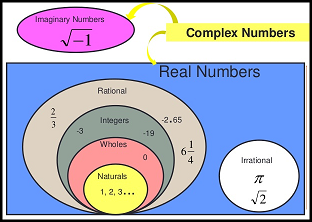What are Real vs Imaginary Numbers Explained? Numbers aren’t just for counting apples or checking your bank balance—some are real, and some are imaginary (but secretly power everything from your smartphone to quantum computers). So here’s Real vs Imaginary Numbers Explained in detail.
Let’s break them down in plain English—no PhD required.
Table of Contents
Real vs Imaginary Numbers Explained :

Real Numbers: The Reliable Workhorses of Math
These are the numbers you’ve known since kindergarten—solid, dependable, and everywhere.
What They Are
✅ Any number that can live on a traditional number line.
✅ Includes:
- Whole numbers (0, 1, 2…)
- Negatives (-3, -10.5)
- Fractions & Decimals (½, 0.333…)
- Irrationals (π, √2—numbers that never end)
Where You See Them Every Day
💰 Money – Your $20 bill (or -$50 overdraft fee)
📏 Measurements – A 5K run, 98.6°F fever
⏰ Time – 3:30 PM, 2.5 seconds on a stopwatch
Real numbers are the backbone of everyday life—they’re concrete, intuitive, and impossible to avoid.
Imaginary Numbers: The Math Rebel No One Saw Coming
These sound like something from a sci-fi novel, but they’re absolutely critical in modern tech.
What They Are
✅ Numbers that square to a negative (which normal numbers can’t do).
✅ Built around the “imaginary unit”: i = √-1
✅ Examples:
- 3i
- -5i
- √-16 = 4i

Why Do We Need Them?
Because some equations are impossible without them. Try solving:
x² + 1 = 0
Without i, you’re stuck—but with it? x = ±i (problem solved!).
Real vs Imaginary: The Ultimate Face-Off
| Feature | Real Numbers | Imaginary Numbers |
|---|---|---|
| Definition | On the number line | Based on i = √-1 |
| Example | 5, -3.7, π | 2i, -4i, √-16 = 4i |
| Squared? | Always ≥ 0 | Always negative |
| Used in | Daily life, finance | Quantum physics, AI, electronics |
When Real + Imaginary = Magic (Complex Numbers)
Combine them (a + bi), and suddenly, math can describe rotations, waves, and even 5G signals.
Example:
- 3 + 4i (Used in MRI scans, Wi-Fi, and electric car motors!)

5 Mind-Blowing Uses of Imaginary Numbers

1. Quantum Computing: They’re Not Optional 🔮
- Qubits (quantum bits) require complex numbers to function.
- A 2023 study in Nature proved that some quantum systems can’t be described without imaginary numbers—meaning they’re fundamental to reality.
2. AI & Deep Learning 🤖
- Complex-valued neural networks (CVNNs) process data differently—sometimes faster than real-number models.
- Used in:
- Speech recognition (Siri, Alexa)
- Image filters (Instagram, TikTok)
- Detecting deepfakes (fighting AI-generated misinformation)
3. Your Phone’s Secret Weapon 📡
- Fourier transforms (math that powers JPEGs, MP3s, and 5G) rely on imaginary numbers to compress data and boost signal clarity.
4. Electric Cars & MRI Machines ⚡🏥
- EV motors use imaginary numbers for precise torque control.
- MRI scans convert magnetic signals into images using complex math.
5. Black Holes & The Universe 🌌
- Einstein’s equations can be extended with complex numbers to model black hole behaviors, wave functions, and even proposed extra dimensions.
- Some physicists argue imaginary numbers might explain dark matter or extra dimensions.
“But… Are Imaginary Numbers Actually Real?”
For centuries, mathematicians debated this. But cutting-edge physics says yes:
“Imaginary numbers aren’t just a trick—they’re woven into the fabric of reality.”
Proof? In 2022, scientists ran a quantum experiment where particles behaved differently only when imaginary numbers were part of the equation.
Why This Matters to You
You might not “see” imaginary numbers, but they’re the reason:
✔ Your Wi-Fi doesn’t drop calls
✔ Your EV accelerates smoothly
✔ Doctors can detect tumors early
Final Thought
- Real numbers = The money in your wallet, the miles on your car.
- Imaginary numbers = The invisible math that makes modern life possible.
So next time someone says “imaginary numbers aren’t real,” hit ‘em with:
“Neither are Wi-Fi signals—until your phone buzzes with a message. Imaginary numbers? Same deal.” 😉

💬 Enjoyed the Read?
If this blew your mind even a little, don’t keep it to yourself—
Share it with a friend, or drop a comment below to let us know what surprised you the most!
Let’s spread the magic of math 🔢✨
👉 Like this? Check out our other blogs on Science and English—packed with fun explanations and useful insights!: 1] What is Gravity? 2] What is Electricity? 3] Layers of Earth 4] Adjective 5] Common mistakes in english grammer and many more.
